MARKETING
The Ultimate List of Free SEO Tools
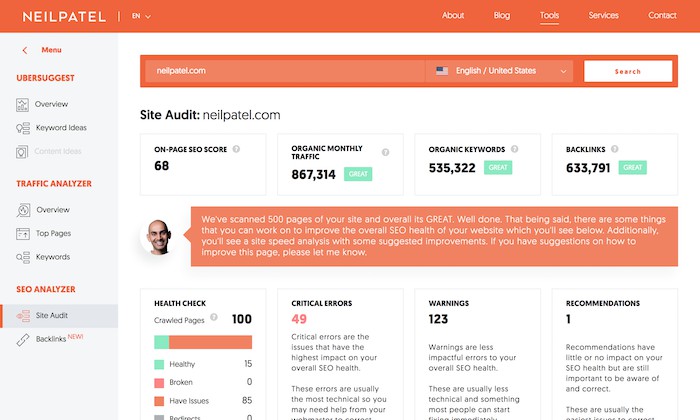
Who says you have to spend money to get more traffic?
For today’s blog post, I thought it would be fun to break down all of the free SEO tools. Sure you may know of some, like Ubersuggest, but there are many more options than just my own tool.
Now before I dive into the tools, I’ve broken them down into the following categories:
- Keyword Research
- Content Marketing
- Rank Tracking
- Link Building
- Technical SEO
So, are you ready to dive in? Let’s get started!
Keyword Research
All of the tools in this category will help you find more keywords. Many of them have different ways of coming up with keyword suggestions, so you may want to check them all out.
Ubersuggest
Ubersuggest has many different keyword research options. First of all, it shows you how many searches a keyword has had over the last 12 months so you can see if there is any seasonality.
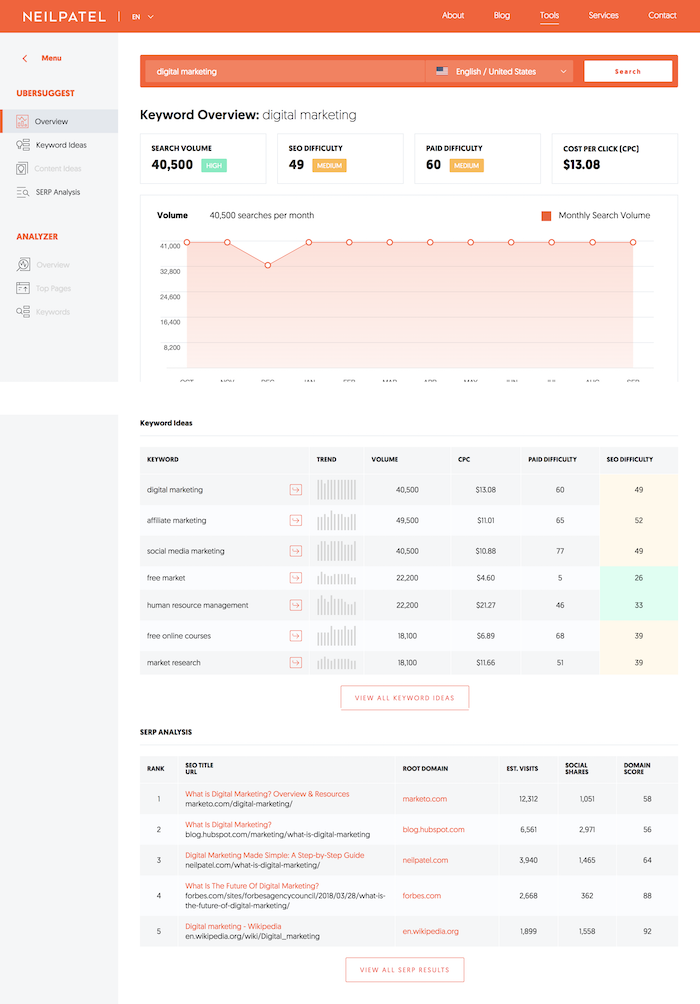
In addition to that, it pulls keywords from a few different sources such as Google Suggest and its own database, it shows you all of the keywords your competition ranks for, and it provides keyword suggestions based on questions, comparisons, and prepositions.
My favorite feature of Ubersuggest’s keyword research capabilities is that it not only can you see how competitive a term is, but it also tells you how many links the average ranking website contains.
That way you know how many links you need to build to rank well.
What’s also unique about Ubersuggest is that it provides local keyword suggestions. This is great if you are trying to do local SEO.
Answer The Public
Answer The Public leverages Google Suggest to find all of the questions people may have related to any industry or keyword.
Just type in a keyword and it will give you a laundry list of questions people are searching for related to that keyword.
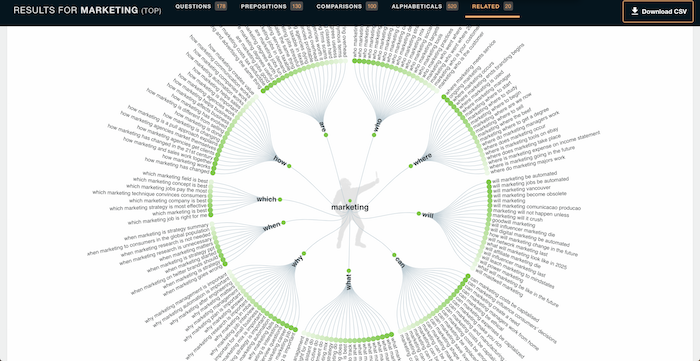
Similar to Ubersuggest it also shows you comparison and preposition related keywords.
What I like about the tool is compared to any competing tool, it represents the data in nice visuals.
KeywordTool.io
SEO doesn’t just exist on Google. You can also rank higher on Amazon, YouTube, Bing, and tons of other sites.
KeywordTool.io uses the same concept of Google Suggest, but for a handful of sites like Amazon, Play Store, and YouTube.
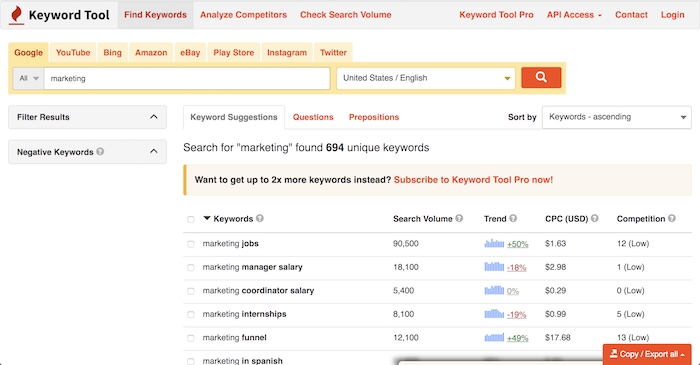
If you are performing SEO on sites other than Google, you should check out KeywordTool.io.
FAQfox
FAQfox is a neat little tool that finds you questions people want to be answered based on any specific site you want information from.
For example, you can type in the word “cat” and quora.com as the URL and it will show you category based questions people are asking on Quora.
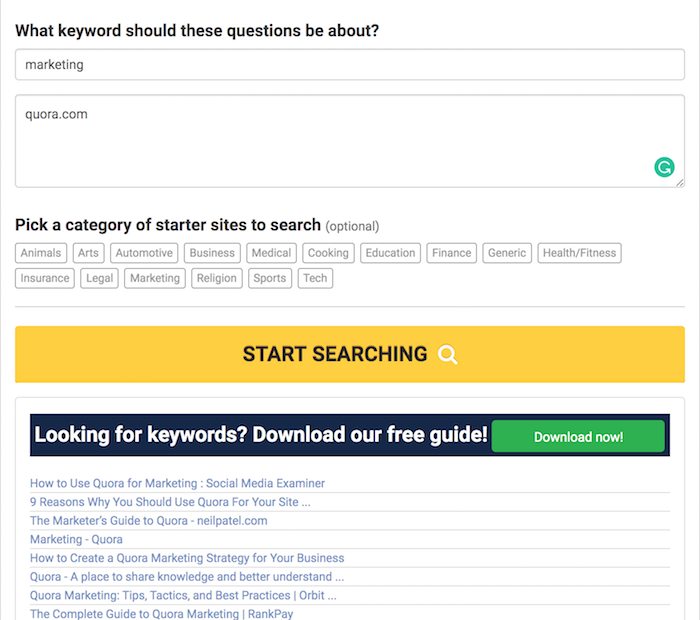
You can do this for Reddit or any other site you want keyword ideas from.
Google Keyword Planner
Of course, the search giant, Google, has its own keyword research tool.
Google Keyword Planner gives you suggestions as well as CPC data and click estimates.
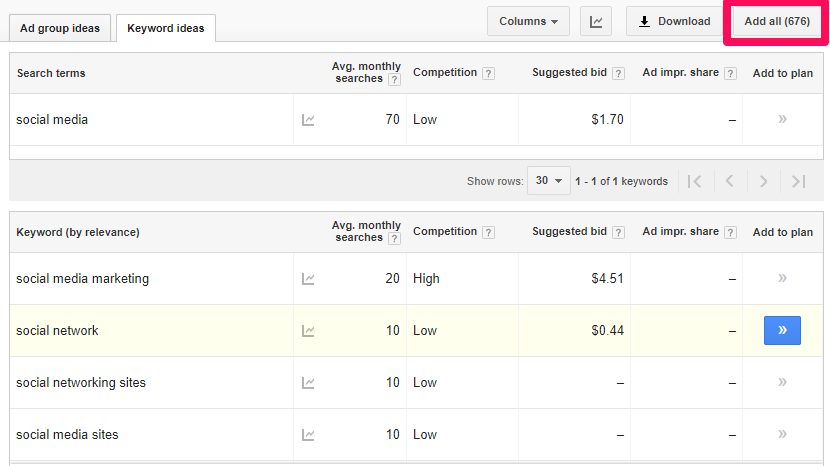
You’ll also notice that a lot of other keyword tools have CPC data, but chances are they are pulling it from Google Keyword Planner.
When you are using Keyword Planner, look for terms with a high CPC as they tend to convert well when you rank for them organically.
Google Trends
Out of all the tools on the list, I probably use Google Trends 3 to 4 times a week. That’s how much I love it.
What I love about Trends is that it shows you what is hot right now. In addition to that, it tells you if an industry is getting less search volume or more over time.
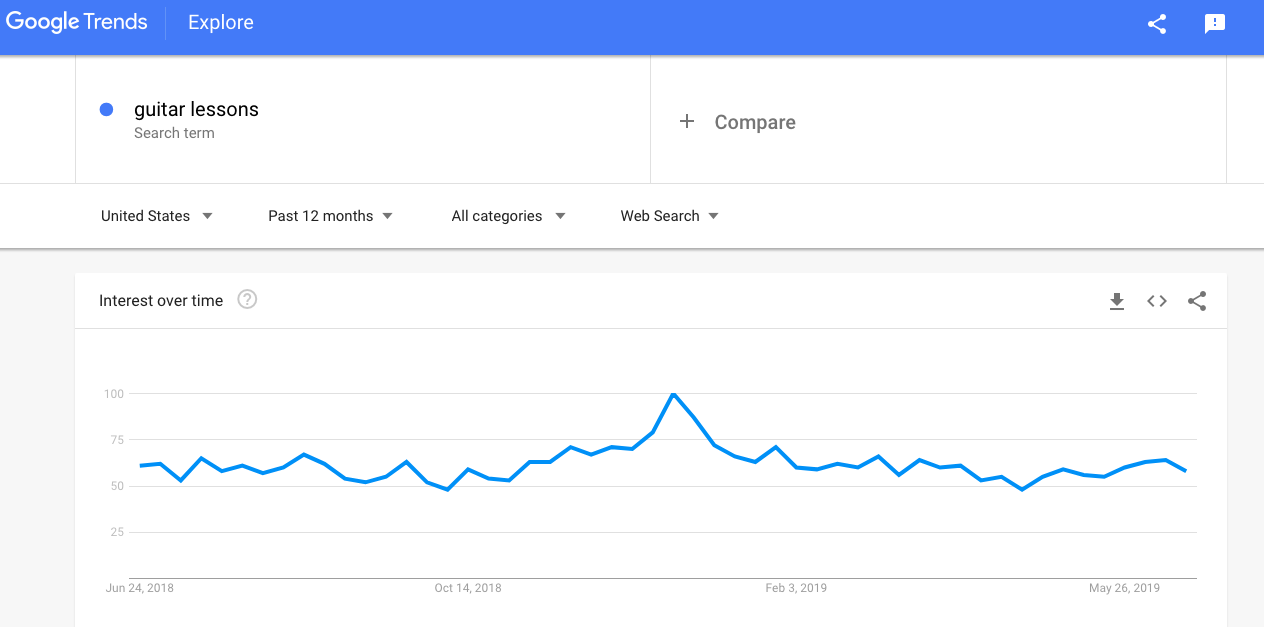
You can also filter your data based on a specific country or you can look at the data from a global perspective.
Soovle
Soovle takes the concept of Google Suggest (autocomplete) but for a lot of the popular sites around the web.
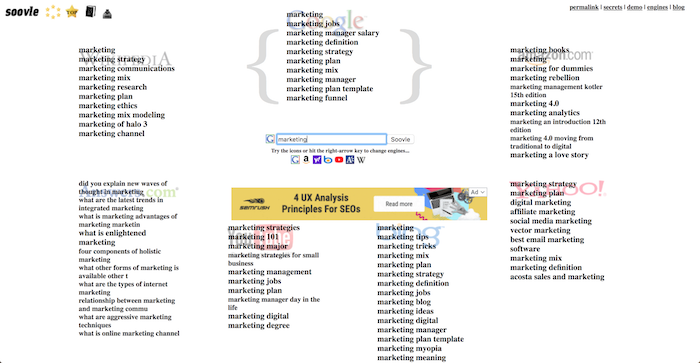
Soovle pulls all of the popular keywords on Google, YouTube, Amazon, Wikipedia, Bing, Yahoo, and Answers.com.
AdWords and SEO Permutation Generator
The AdWords and SEO Permutation Generator is a super simple tool that helps you get creative with your keyword research.
You enter in a handful of terms you want to target and it will combine them to make different variations for you.
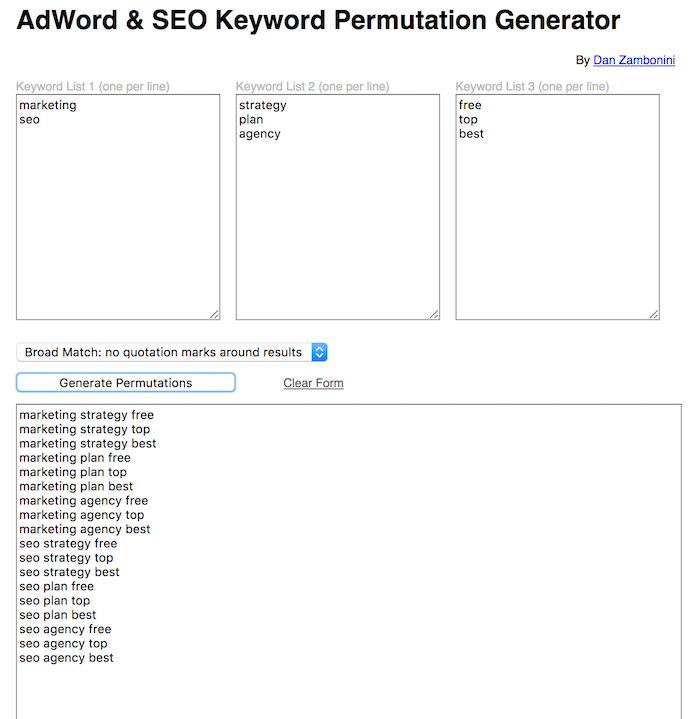
Not all of the keywords will be popular when it comes to search volume, but it will give you a sense of how you can go after long-tail variations within your site.
Keyworddit
Reddit has a ton of categories (subreddits) and Keyworddit helps you find all of the keywords within that subreddit.
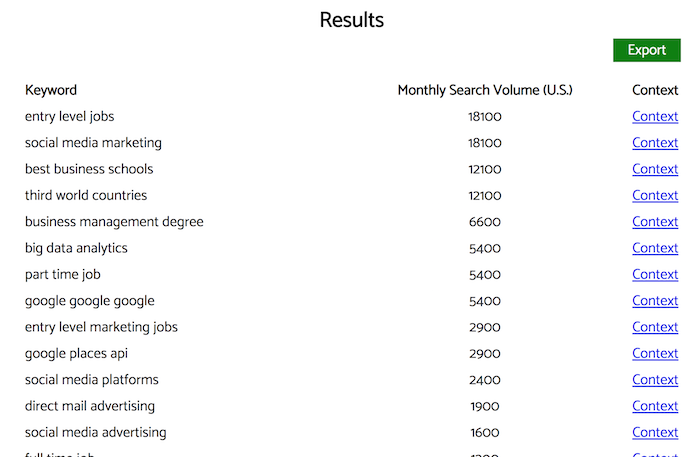
What’s neat is it even breaks down the volume for each of those keywords. That way you can quickly see if any are worth going after.
Generally speaking, you’ll want to use tools like this as it will give you a new perspective on keyword research.
Pulling results from Google is something that all SEOs already do. Because of that, you need to use other sources if you want to get a leg up on your competition.
Bulk Keyword Generator
The Bulk Keyword Generator by Higher Visibility does keyword research a bit differently than most of the keyword tools out there.
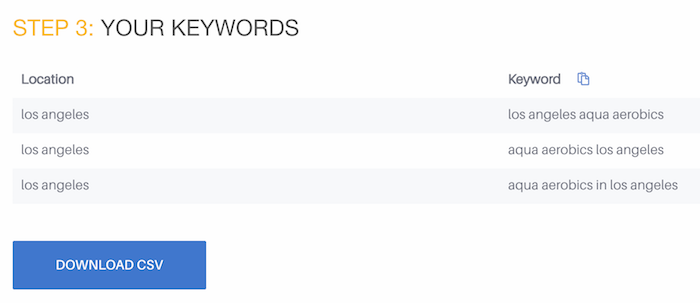
First, you pick a business category. Then you select the type of business you have and enter in any locations you are targeting.
You’ll then be given a list of keywords that you can potentially target.
What I like about this tool is that it makes things super simple, especially if you are new to SEO.
WordTracker Scout
WordTracker Scout is a browser extension that gives you a list of keyword ideas from any web page.

Just browse any site or check out your competition, click a button and boom, you are given ideas on keywords that other people are using.
It breaks the keywords down by relevance and volume.
SearchVolume.io
When you are doing keyword research, how do you know a keyword is getting enough searches?
SearchVolume.io lets you bulk upload up to 800 keywords and it tells you how popular each keyword is.
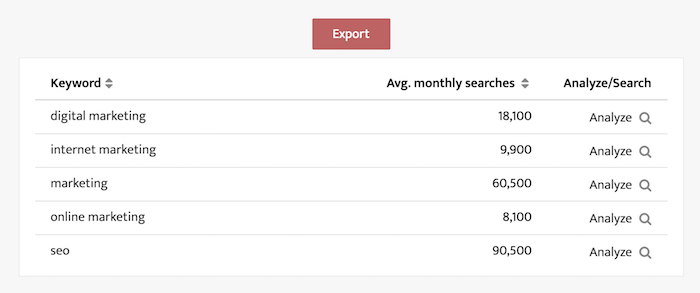
The tool also works for a handful of other regions, such as Brazil, France, and Italy.
Google Location Changer
Serps has a neat tool that works well if you are doing international SEO.
Their Google Location Changer allows you to search Google in any country or city. Just type in a keyword and you’ll see who ranks.
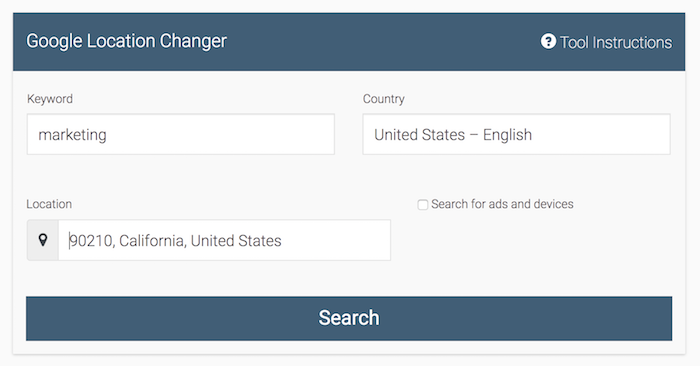
Using this tool in combination with WordTracker Scout can give you unique keyword suggestions.
Content Marketing
Content is the one thing we all have to create if we want more search traffic.
Here are free content marketing tools that can help you get the most out of your search traffic.
Animalz Revive
Have you noticed that your rankings decrease over time?
It’s not just because of Google algorithm updates. In most cases, your old content won’t perform as well because it’s old.
Animalz Revive shows you which content pieces are dying over time.
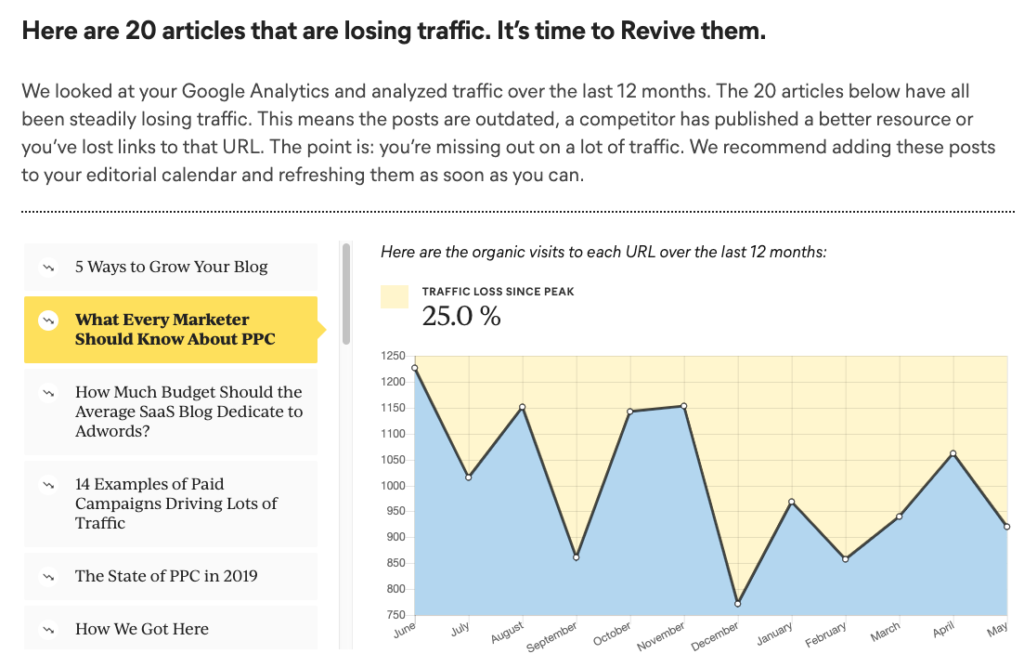
That way you know what to focus on. Just look at the ones that have declined the most and then spruce them up so you can get more rankings.
What’s cool about this tool is it will save you a lot of time. For example, my team updates 90 pieces of content a month. The last thing you want to do is waste a ton of time on content that never had much traffic.
Google Search Console
Most people use Google Search Console to see which keywords are driving them traffic.
My favorite way of using Search Console is to see which one of my blog posts are getting a lot of search impressions but have less than a 4% click-through rate.
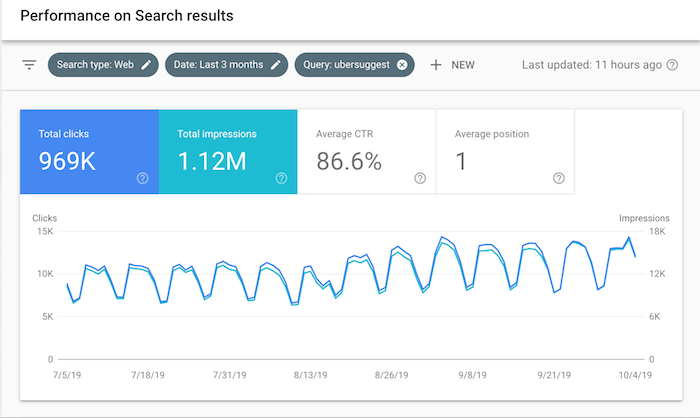
I then go in and modify each of those pages to include the right keywords in my meta tags. Then I look to see which keywords I am ranking for but not really targeting yet, and then either create new content around those terms or modify existing content to also target them.
Content Ideas
Ubersuggest has a feature similar to Buzzsumo but it is 100% free. It’s called Content Ideas.
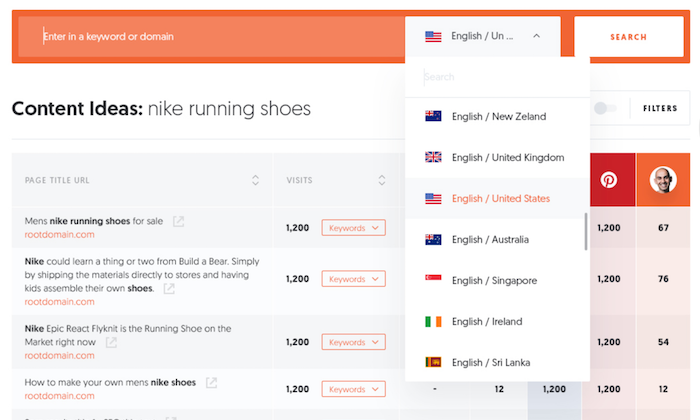
All you have to do is enter in a keyword or phrase and it will show you all of the popular blog posts that contain that term.
The blog posts are then sorted by social shares, backlinks, and search traffic.
This helps you create content around topics people want to read, which means more traffic.
Hreflang Tag Generator
One of my biggest traffic gains has come from translating my content.
A lot of people ask me if they would be penalized from duplicating and translation their content.
The answer is no.
All you need to do is use the Hreflang Tag Generator.
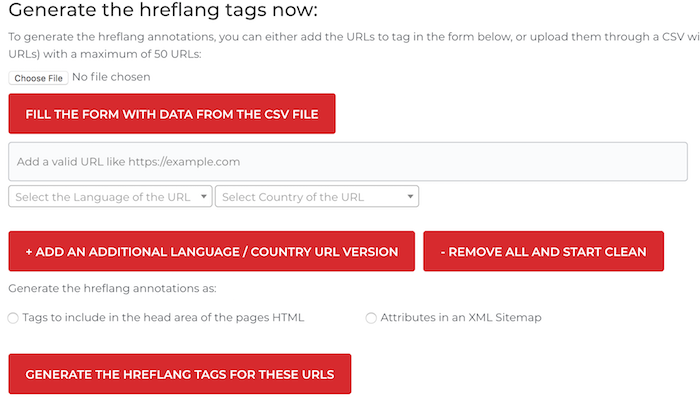
This tool creates tags for you to place in your HTML code so Google knows you are targeting specific languages and countries with certain content pages.
Portent Title Generator
For every 10 people that see your headline, only 2 on average will continue to read your content.
In other words, content marketing is all about the headline.
If you are struggling to create headlines, check out the Portent Title Generator.

Just insert a keyword or phrase and it will generate dozens of suggestions for you.
Title Capitalization Tool
Not sure which words in your title should be capitalized?
This Title Capitalization tool will take care of that for you.
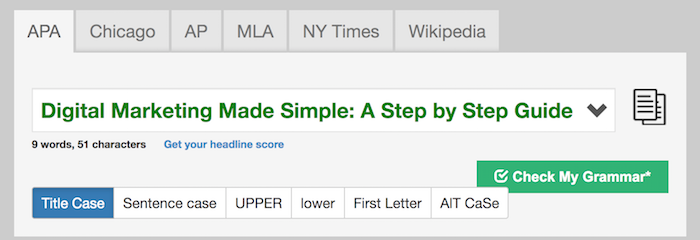
It may not sound important to you, but if your titles look off, people may not click through from SERP results to read your content, which can decrease your rankings over time.
Grammarly
Every SEO should be using Grammarly.
Which do you think Google prefers? Ranking a blog post that reads well or one that contains a lot of spelling and grammar errors?

Grammarly helps you avoid spelling mistakes. This is really important if you want to rank on Google.
Google SERP Tool
Have you noticed that some listings on Google get cut off because the title is too long?
A big misconception is Google uses character counts for meta tags. In reality, they count pixels.
Google SERP Tool will tell you how many pixels your meta tags contain and if they will get cut off by Google.
![]()
It also shows you a preview of what your web pages will look like on Google.
Rank Tracking
Google Analytics is a great tool to show you your overall traffic, but it doesn’t tell you where you rank.
If you want to track your rankings, you’ll need to use some tools.
Google Search Console
I know I mentioned this tool above, but Google Search Console is the most unique rank tracking tool out there.
Because this tool is from Google, they can tell you your average ranking for any one of your pages per country.
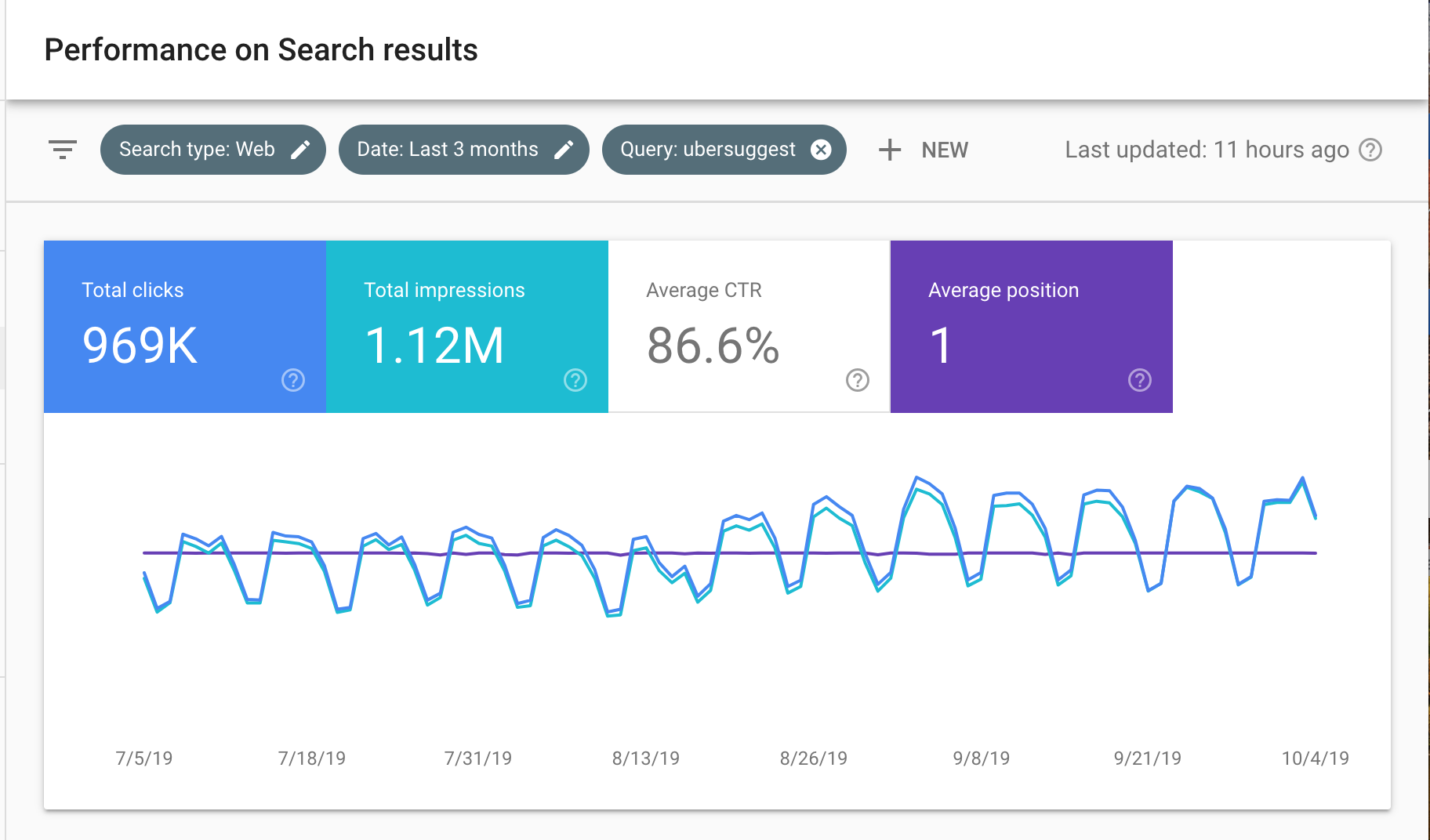
And because the data comes from them, they average it out to give you accurate information.
You can also go back 16 months and see how your rankings have changed over time.
Ubersuggest
Again, I know I also mentioned Ubersuggest above, but it now has a free rank tracking feature.
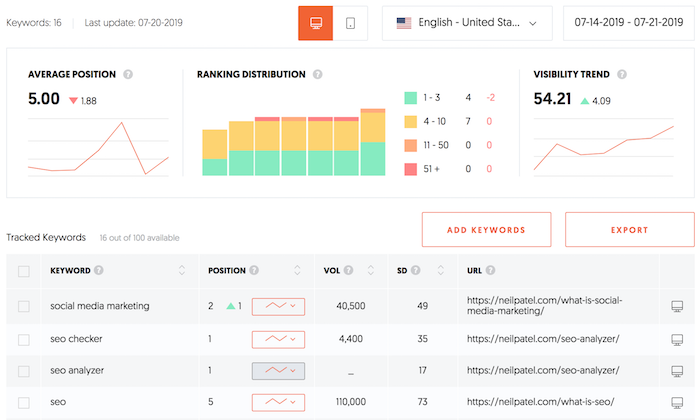
It provides the same features as those paid rank trackers. You can track your rankings daily for any keyword or groups of keywords for any country, city, or county.
It also saves your data for you so you can go back as far as you want to see if your rankings have been increasing or decreasing.
Search Latte
If you want to track your rankings manually, you can do so with Search Latte.

Just put in a keyword and select the language and country so you can see all of the sites that rank in the top 100.
You can then manually find your site and keep track to see if you are improving or declining.
You may want to use Search Latte in combination with Excel as you can create a daily log of your rankings.
Link Building
You used to have to pay for tools if you wanted link data, but that’s not the case anymore. Here are the free link tools you can use.
MozBar
This is probably my favorite link tool that I use.
Even though Google doesn’t use domain authority, in general, the higher the authority of a site that is linking to you, the better off you are.
MozBar shows you the domain authority and page authority of every page on the web.

If you are going to build links, focus on the sites with the highest authority.
SEOgadget for Excel
If you are like me, you probably love using Excel when you are building links.
SEOgadget for Excel makes it really easy to pull in data from Majestic and Moz.

If you haven’t tried this yet, you should consider it. It will make it easier for you to find new insights and run your own calculations.
Backlinks
Backlinks is a free tool that shows you all of your backlinks. There are no limits in row count or anything like that… you can just see everyone who links to you.

You can see if any of your links are dofollow or nofollow as well as the anchor text.
You can filter the results to find backlink opportunities when researching competitors and you have the option to look up link data on a domain, subdomain, or a specific URL.
It will also show when a link was first found and last crawled and the authority of each link.
Bulk Metrics Checker
Tired of looking up the domain and page authority manually on each of your pages or sites?
Bulk Metrics Checker solves that for you.

Just upload a list of URLs and within seconds you’ll have a list of your page authority per URL. You can also do the same for domains and upload dozens of domains at once.
Technical SEO
SEO has changed. You no longer can do just a few things and expect your site to rank well. You have to do everything if you expect to beat your competition.
And when I mean everything, that includes technical SEO.
SEO Analyzer
If you haven’t already, try running your URL through my SEO Analyzer.
It will tell you what’s wrong with each of your web pages.
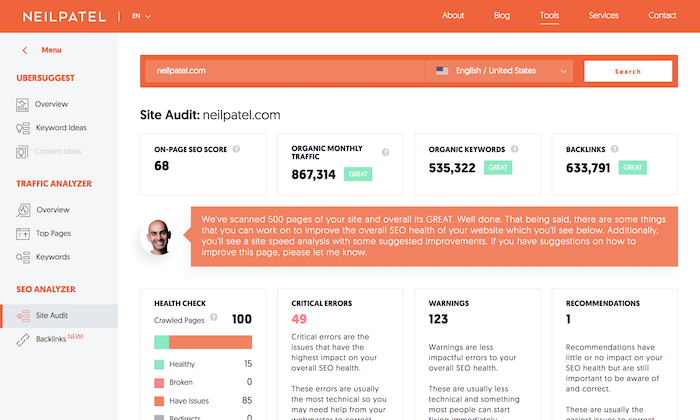
From duplicate meta tags and redirect errors to sitemaps and much more… it pretty much looks at every major factor when it comes to SEO.
It will even tell you your overall site speed and what you need to fix in which order to get the maximum results.
And if you register for a free account, it automatically checks for errors each week on your behalf.
Google Analytics Referrer Spam Killer
When you are doing SEO, there is a good chance that your Google Analytics gets messed up by referral spam.
Google Analytics Referrer Spam Killer solves that problem by connecting with your Google Analytics account and blocking off the most common referral spam.

Once you connect it, you’ll find that your data is much more accurate so you can make better SEO decisions.
Pagespeed Insights
Speed is everything. The faster your site loads the better you will rank, especially when it comes to Google’s mobile index.
Pagespeed Insights tells you what you need to fix for your site to load fast on any device.

It doesn’t matter if you are optimizing for tablet devices, desktop, or mobile… it will tell you what to fix.
Pingdom
Fixing your code is one thing, but you’ll also want to make sure your site loads fast overall.
Your overall load time is affected by things like your server and CDN.
Pingdom tells you your actual load time.

With Pingdom, you can pick which location to test your load speed from and it tells you what code on your site is causing the biggest slowdown.
Website Penalty Checker
With over 3,200 algorithm updates each year to Google, how do you know if you have been affected by an update?
Is it related to a core update, your content, or link building?
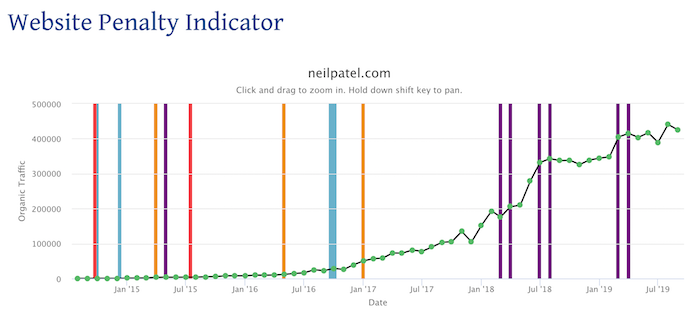
Website Penalty Checker tells you that.
In a nice graph, it shows your traffic over time and tells you if a Google update has caused your traffic to go up or down.
Structured Data Markup Helper
A simple way to increase your search traffic is to use schema markup.
But there is one big issue, schema markup is a bit complicated to implement. Because of that, Google created a Structured Data Markup Helper to guide you.
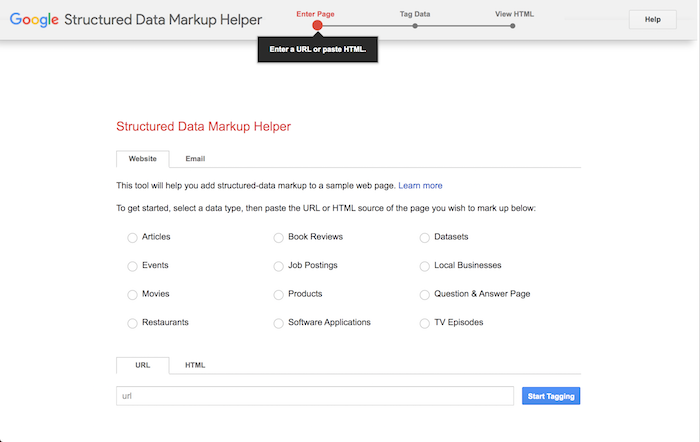
All you have to do is select what kind of markup you want to use, type in your URL, and go through the walkthrough wizard.
And at the end, you’ll be given code that you just paste within HTML.
Woorank
Looking for a simple SEO analysis? Woorank shows you a simple report of what’s wrong with your web page.
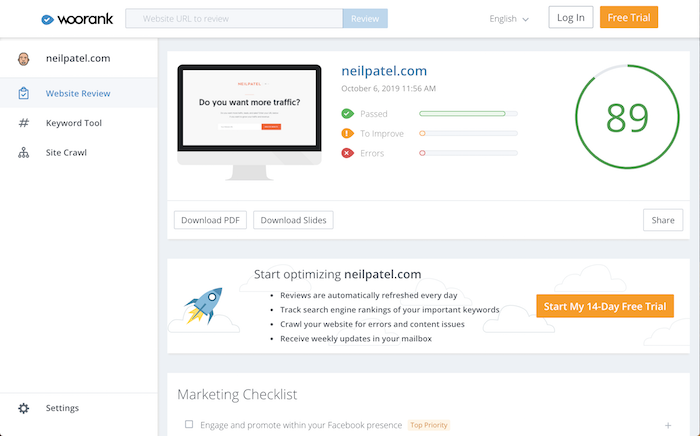
All you have to do is type in your domain and within a minute you’ll see a thorough report of what you need to fix.
What I love about Woorank is that it is a great tool for beginners because of their easy-to-use interface.
SEOptimer
Just like Woorank, SEOptimer is a simple tool that gives you a technical overview of your on-page SEO as well as your content.
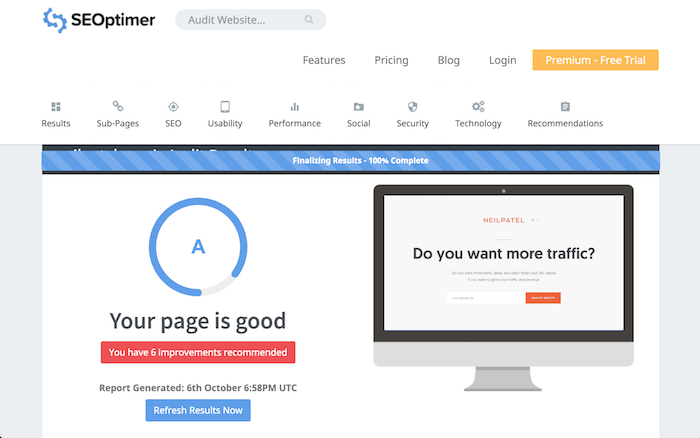
It breaks down things like page speed as well in addition to showing you how your website loads for both desktop and mobile devices.
You can even see social sharing data.
Varvy
Varvy provides a detailed technical checklist of all things related to your SEO.
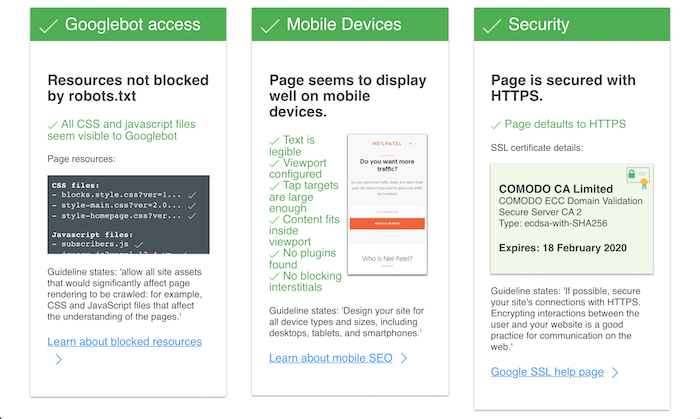
From your Robots.txt file and your sitemap to security settings and even your links, it covers all the bases.
If you don’t have a technical background, Varvy might be a bit complex unless you take the time to read each of their articles that outline what each tip/recommendation means.
301 Redirect Code Generator
When you are doing SEO long enough, eventually you find yourself changing your older URLs.
But if you don’t add a 301 redirect, you’ll lose your rankings.
301 Redirect Code Generator creates the code you’ll need to tell search engines your URLs have changed.

Panguin Tool
This tool is similar to the Website Penalty Checker but it is more accurate because it connects directly with your Analytics account.
If you think you have been hit with a Google penalty, use the Panguin Tool.
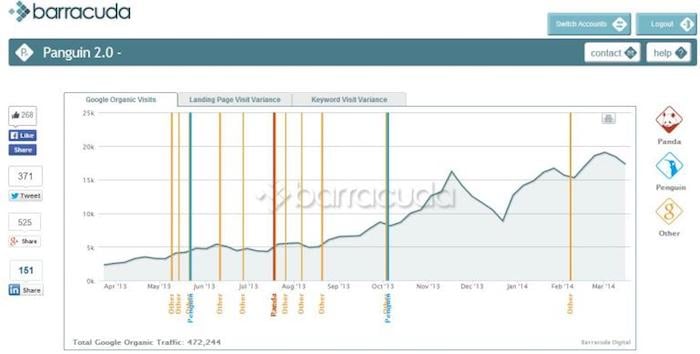
Now if you want to see if your competition has also been hit, this tool won’t work, but the Website Penalty Checker will.
None-the-less, they are both great tools.
Google Search Console
I have to include this tool again. Why? Because if there is something wrong with your site, such as it getting hacked, it will notify you.
It even tells you the pages that were indexed and which ones aren’t.
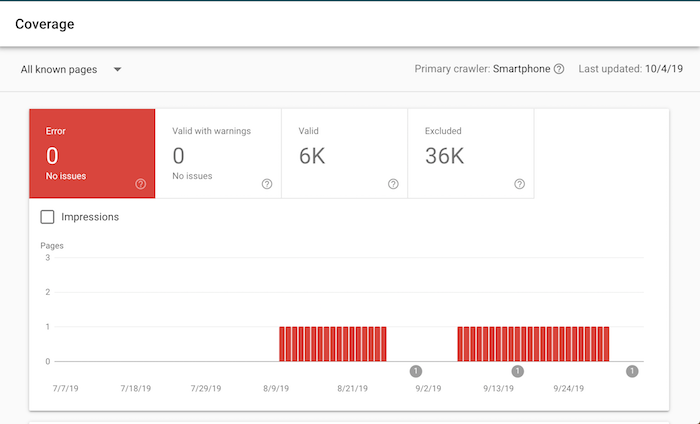
One thing that you have to do within your Search Console is to submit an XML sitemap.
XML Sitemaps
XML Sitemaps generates a sitemap for you that you can submit to Google Search Console.

You’ll need to do this so you can get more of your content indexed.
Submitting a sitemap doesn’t guarantee that Google will index your content, but it does help… mainly for sites with low domain authority.
Conclusion
Tools don’t have to cost money. I got into SEO because it was the free traffic source I could leverage to compete with the big companies.
If you want to grow your search rankings, you can leverage one of the free SEO tools above.
Sure, there are amazing paid tools as well, but why not start with the free stuff?
What other free SEO tools do you use?
MARKETING
Ecommerce evolution: Blurring the lines between B2B and B2C

Understanding convergence
B2B and B2C ecommerce are two distinct models of online selling. B2B ecommerce is between businesses, such as wholesalers, distributors, and manufacturers. B2C ecommerce refers to transactions between businesses like retailers and consumer brands, directly to individual shoppers.
However, in recent years, the boundaries between these two models have started to fade. This is known as the convergence between B2B and B2C ecommerce and how they are becoming more similar and integrated.
Source: White Paper: The evolution of the B2B Consumer Buyer (ClientPoint, Jan 2024)
What’s driving this change?
Ever increasing customer expectations
Customers today expect the same level of convenience, speed, and personalization in their B2B transactions as they do in their B2C interactions. B2B buyers are increasingly influenced by their B2C experiences. They want research, compare, and purchase products online, seamlessly transitioning between devices and channels. They also prefer to research and purchase online, using multiple devices and channels.
Forrester, 68% of buyers prefer to research on their own, online . Customers today expect the same level of convenience, speed, and personalization in their B2B transactions as they do in their B2C interactions. B2B buyers are increasingly influenced by their B2C experiences. They want research, compare, and purchase products online, seamlessly transitioning between devices and channels. They also prefer to research and purchase online, using multiple devices and channels
Technology and omnichannel strategies
Technology enables B2B and B2C ecommerce platforms to offer more features and functionalities, such as mobile optimization, chatbots, AI, and augmented reality. Omnichannel strategies allow B2B and B2C ecommerce businesses to provide a seamless and consistent customer experience across different touchpoints, such as websites, social media, email, and physical stores.
However, with every great leap forward comes its own set of challenges. The convergence of B2B and B2C markets means increased competition. Businesses now not only have to compete with their traditional rivals, but also with new entrants and disruptors from different sectors. For example, Amazon Business, a B2B ecommerce platform, has become a major threat to many B2B ecommerce businesses, as it offers a wide range of products, low prices, and fast delivery
“Amazon Business has proven that B2B ecommerce can leverage popular B2C-like functionality” argues Joe Albrecht, CEO / Managing Partner, Xngage. . With features like Subscribe-and-Save (auto-replenishment), one-click buying, and curated assortments by job role or work location, they make it easy for B2B buyers to go to their website and never leave. Plus, with exceptional customer service and promotional incentives like Amazon Business Prime Days, they have created a reinforcing loyalty loop.
And yet, according to Barron’s, Amazon Business is only expected to capture 1.5% of the $5.7 Trillion addressable business market by 2025. If other B2B companies can truly become digital-first organizations, they can compete and win in this fragmented space, too.”
If other B2B companies can truly become digital-first organizations, they can also compete and win in this fragmented space
Joe AlbrechtCEO/Managing Partner, XNGAGE
Increasing complexity
Another challenge is the increased complexity and cost of managing a converging ecommerce business. Businesses have to deal with different customer segments, requirements, and expectations, which may require different strategies, processes, and systems. For instance, B2B ecommerce businesses may have to handle more complex transactions, such as bulk orders, contract negotiations, and invoicing, while B2C ecommerce businesses may have to handle more customer service, returns, and loyalty programs. Moreover, B2B and B2C ecommerce businesses must invest in technology and infrastructure to support their convergence efforts, which may increase their operational and maintenance costs.
How to win
Here are a few ways companies can get ahead of the game:
Adopt B2C-like features in B2B platforms
User-friendly design, easy navigation, product reviews, personalization, recommendations, and ratings can help B2B ecommerce businesses to attract and retain more customers, as well as to increase their conversion and retention rates.
According to McKinsey, ecommerce businesses that offer B2C-like features like personalization can increase their revenues by 15% and reduce their costs by 20%. You can do this through personalization of your website with tools like Product Recommendations that help suggest related products to increase sales.
Focus on personalization and customer experience
B2B and B2C ecommerce businesses need to understand their customers’ needs, preferences, and behaviors, and tailor their offerings and interactions accordingly. Personalization and customer experience can help B2B and B2C ecommerce businesses to increase customer satisfaction, loyalty, and advocacy, as well as to improve their brand reputation and competitive advantage. According to a Salesforce report, 88% of customers say that the experience a company provides is as important as its products or services.
Market based on customer insights
Data and analytics can help B2B and B2C ecommerce businesses to gain insights into their customers, markets, competitors, and performance, and to optimize their strategies and operations accordingly. Data and analytics can also help B2B and B2C ecommerce businesses to identify new opportunities, trends, and innovations, and to anticipate and respond to customer needs and expectations. According to McKinsey, data-driven organizations are 23 times more likely to acquire customers, six times more likely to retain customers, and 19 times more likely to be profitable.
What’s next?
The convergence of B2B and B2C ecommerce is not a temporary phenomenon, but a long-term trend that will continue to shape the future of ecommerce. According to Statista, the global B2B ecommerce market is expected to reach $20.9 trillion by 2027, surpassing the B2C ecommerce market, which is expected to reach $10.5 trillion by 2027. Moreover, the report predicts that the convergence of B2B and B2C ecommerce will create new business models, such as B2B2C, B2A (business to anyone), and C2B (consumer to business).
Therefore, B2B and B2C ecommerce businesses need to prepare for the converging ecommerce landscape and take advantage of the opportunities and challenges it presents. Here are some recommendations for B2B and B2C ecommerce businesses to navigate the converging landscape:
- Conduct a thorough analysis of your customers, competitors, and market, and identify the gaps and opportunities for convergence.
- Develop a clear vision and strategy for convergence, and align your goals, objectives, and metrics with it.
- Invest in technology and infrastructure that can support your convergence efforts, such as cloud, mobile, AI, and omnichannel platforms.
- Implement B2C-like features in your B2B platforms, and vice versa, to enhance your customer experience and satisfaction.
- Personalize your offerings and interactions with your customers, and provide them with relevant and valuable content and solutions.
- Leverage data and analytics to optimize your performance and decision making, and to innovate and differentiate your business.
- Collaborate and partner with other B2B and B2C ecommerce businesses, as well as with other stakeholders, such as suppliers, distributors, and customers, to create value and synergy.
- Monitor and evaluate your convergence efforts, and adapt and improve them as needed.
By following these recommendations, B2B and B2C ecommerce businesses can bridge the gap between their models and create a more integrated and seamless ecommerce experience for their customers and themselves.
MARKETING
Streamlining Processes for Increased Efficiency and Results

How can businesses succeed nowadays when technology rules? With competition getting tougher and customers changing their preferences often, it’s a challenge. But using marketing automation can help make things easier and get better results. And in the future, it’s going to be even more important for all kinds of businesses.
So, let’s discuss how businesses can leverage marketing automation to stay ahead and thrive.
Benefits of automation marketing automation to boost your efforts
First, let’s explore the benefits of marketing automation to supercharge your efforts:
Marketing automation simplifies repetitive tasks, saving time and effort.
With automated workflows, processes become more efficient, leading to better productivity. For instance, automation not only streamlines tasks like email campaigns but also optimizes website speed, ensuring a seamless user experience. A faster website not only enhances customer satisfaction but also positively impacts search engine rankings, driving more organic traffic and ultimately boosting conversions.
Automation allows for precise targeting, reaching the right audience with personalized messages.
With automated workflows, processes become more efficient, leading to better productivity. A great example of automated workflow is Pipedrive & WhatsApp Integration in which an automated welcome message pops up on their WhatsApp
within seconds once a potential customer expresses interest in your business.
Increases ROI
By optimizing campaigns and reducing manual labor, automation can significantly improve return on investment.
Leveraging automation enables businesses to scale their marketing efforts effectively, driving growth and success. Additionally, incorporating lead scoring into automated marketing processes can streamline the identification of high-potential prospects, further optimizing resource allocation and maximizing conversion rates.
Harnessing the power of marketing automation can revolutionize your marketing strategy, leading to increased efficiency, higher returns, and sustainable growth in today’s competitive market. So, why wait? Start automating your marketing efforts today and propel your business to new heights, moreover if you have just learned ways on how to create an online business
How marketing automation can simplify operations and increase efficiency
Understanding the Change
Marketing automation has evolved significantly over time, from basic email marketing campaigns to sophisticated platforms that can manage entire marketing strategies. This progress has been fueled by advances in technology, particularly artificial intelligence (AI) and machine learning, making automation smarter and more adaptable.
One of the main reasons for this shift is the vast amount of data available to marketers today. From understanding customer demographics to analyzing behavior, the sheer volume of data is staggering. Marketing automation platforms use this data to create highly personalized and targeted campaigns, allowing businesses to connect with their audience on a deeper level.
The Emergence of AI-Powered Automation
In the future, AI-powered automation will play an even bigger role in marketing strategies. AI algorithms can analyze huge amounts of data in real-time, helping marketers identify trends, predict consumer behavior, and optimize campaigns as they go. This agility and responsiveness are crucial in today’s fast-moving digital world, where opportunities come and go in the blink of an eye. For example, we’re witnessing the rise of AI-based tools from AI website builders, to AI logo generators and even more, showing that we’re competing with time and efficiency.
Combining AI-powered automation with WordPress management services streamlines marketing efforts, enabling quick adaptation to changing trends and efficient management of online presence.
Moreover, AI can take care of routine tasks like content creation, scheduling, and testing, giving marketers more time to focus on strategic activities. By automating these repetitive tasks, businesses can work more efficiently, leading to better outcomes. AI can create social media ads tailored to specific demographics and preferences, ensuring that the content resonates with the target audience. With the help of an AI ad maker tool, businesses can efficiently produce high-quality advertisements that drive engagement and conversions across various social media platforms.
Personalization on a Large Scale
Personalization has always been important in marketing, and automation is making it possible on a larger scale. By using AI and machine learning, marketers can create tailored experiences for each customer based on their preferences, behaviors, and past interactions with the brand.
This level of personalization not only boosts customer satisfaction but also increases engagement and loyalty. When consumers feel understood and valued, they are more likely to become loyal customers and brand advocates. As automation technology continues to evolve, we can expect personalization to become even more advanced, enabling businesses to forge deeper connections with their audience. As your company has tiny homes for sale California, personalized experiences will ensure each customer finds their perfect fit, fostering lasting connections.
Integration Across Channels
Another trend shaping the future of marketing automation is the integration of multiple channels into a cohesive strategy. Today’s consumers interact with brands across various touchpoints, from social media and email to websites and mobile apps. Marketing automation platforms that can seamlessly integrate these channels and deliver consistent messaging will have a competitive edge. When creating a comparison website it’s important to ensure that the platform effectively aggregates data from diverse sources and presents it in a user-friendly manner, empowering consumers to make informed decisions.
Omni-channel integration not only betters the customer experience but also provides marketers with a comprehensive view of the customer journey. By tracking interactions across channels, businesses can gain valuable insights into how consumers engage with their brand, allowing them to refine their marketing strategies for maximum impact. Lastly, integrating SEO services into omni-channel strategies boosts visibility and helps businesses better understand and engage with their customers across different platforms.
The Human Element
While automation offers many benefits, it’s crucial not to overlook the human aspect of marketing. Despite advances in AI and machine learning, there are still elements of marketing that require human creativity, empathy, and strategic thinking.
Successful marketing automation strikes a balance between technology and human expertise. By using automation to handle routine tasks and data analysis, marketers can focus on what they do best – storytelling, building relationships, and driving innovation.
Conclusion
The future of marketing automation looks promising, offering improved efficiency and results for businesses of all sizes.
As AI continues to advance and consumer expectations change, automation will play an increasingly vital role in keeping businesses competitive.
By embracing automation technologies, marketers can simplify processes, deliver more personalized experiences, and ultimately, achieve their business goals more effectively than ever before.
MARKETING
Will Google Buy HubSpot? | Content Marketing Institute

Google + HubSpot. Is it a thing?
This week, a flurry of news came down about Google’s consideration of purchasing HubSpot.
The prospect dismayed some. It delighted others.
But is it likely? Is it even possible? What would it mean for marketers? What does the consideration even mean for marketers?
Well, we asked CMI’s chief strategy advisor, Robert Rose, for his take. Watch this video or read on:
Why Alphabet may want HubSpot
Alphabet, the parent company of Google, apparently is contemplating the acquisition of inbound marketing giant HubSpot.
The potential price could be in the range of $30 billion to $40 billion. That would make Alphabet’s largest acquisition by far. The current deal holding that title happened in 2011 when it acquired Motorola Mobility for more than $12 billion. It later sold it to Lenovo for less than $3 billion.
If the HubSpot deal happens, it would not be in character with what the classic evil villain has been doing for the past 20 years.
At first glance, you might think the deal would make no sense. Why would Google want to spend three times as much as it’s ever spent to get into the inbound marketing — the CRM and marketing automation business?
At a second glance, it makes a ton of sense.
I don’t know if you’ve noticed, but I and others at CMI spend a lot of time discussing privacy, owned media, and the deprecation of the third-party cookie. I just talked about it two weeks ago. It’s really happening.
All that oxygen being sucked out of the ad tech space presents a compelling case that Alphabet should diversify from third-party data and classic surveillance-based marketing.
Yes, this potential acquisition is about data. HubSpot would give Alphabet the keys to the kingdom of 205,000 business customers — and their customers’ data that almost certainly numbers in the tens of millions. Alphabet would also gain access to the content, marketing, and sales information those customers consumed.
Conversely, the deal would provide an immediate tip of the spear for HubSpot clients to create more targeted programs in the Alphabet ecosystem and upload their data to drive even more personalized experiences on their own properties and connect them to the Google Workspace infrastructure.
When you add in the idea of Gemini, you can start to see how Google might monetize its generative AI tool beyond figuring out how to use it on ads on search results pages.
What acquisition could mean for HubSpot customers
I may be stretching here but imagine this world. As a Hubspoogle customer, you can access an interface that prioritizes your owned media data (e.g., your website, your e-commerce catalog, blog) when Google’s Gemini answers a question).
Recent reports also say Google may put up a paywall around the new premium features of its artificial intelligence-powered Search Generative Experience. Imagine this as the new gating for marketing. In other words, users can subscribe to Google’s AI for free, but Hubspoogle customers can access that data and use it to create targeted offers.
The acquisition of HubSpot would immediately make Google Workspace a more robust competitor to Microsoft 365 Office for small- and medium-sized businesses as they would receive the ADDED capability of inbound marketing.
But in the world of rented land where Google is the landlord, the government will take notice of the acquisition. But — and it’s a big but, I cannot lie (yes, I just did that). The big but is whether this acquisition dance can happen without going afoul of regulatory issues.
Some analysts say it should be no problem. Others say, “Yeah, it wouldn’t go.” Either way, would anybody touch it in an election year? That’s a whole other story.
What marketers should realize
So, what’s my takeaway?
It’s a remote chance that Google will jump on this hard, but stranger things have happened. It would be an exciting disruption in the market.
The sure bet is this. The acquisition conversation — as if you needed more data points — says getting good at owned media to attract and build audiences and using that first-party data to provide better communication and collaboration with your customers are a must.
It’s just a matter of time until Google makes a move. They might just be testing the waters now, but they will move here. But no matter what they do, if you have your customer data house in order, you’ll be primed for success.
HANDPICKED RELATED CONTENT:
Cover image by Joseph Kalinowski/Content Marketing Institute
-

 MARKETING7 days ago
MARKETING7 days agoRoundel Media Studio: What to Expect From Target’s New Self-Service Platform
-

 SEO6 days ago
SEO6 days agoGoogle Limits News Links In California Over Proposed ‘Link Tax’ Law
-
SEARCHENGINES6 days ago
Daily Search Forum Recap: April 12, 2024
-

 SEARCHENGINES5 days ago
SEARCHENGINES5 days agoGoogle Core Update Volatility, Helpful Content Update Gone, Dangerous Google Search Results & Google Ads Confusion
-

 SEO5 days ago
SEO5 days ago10 Paid Search & PPC Planning Best Practices
-

 MARKETING6 days ago
MARKETING6 days ago2 Ways to Take Back the Power in Your Business: Part 2
-

 SEARCHENGINES4 days ago
SEARCHENGINES4 days agoWeekend Google Core Ranking Volatility
-

 MARKETING4 days ago
MARKETING4 days ago5 Psychological Tactics to Write Better Emails













